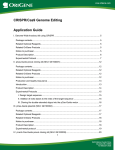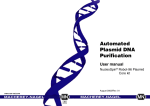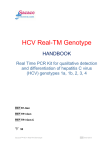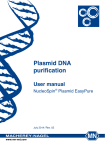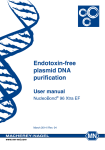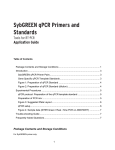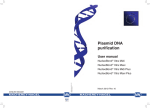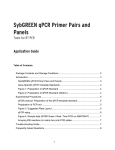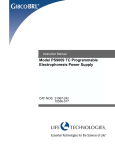Download NOTICE: Kits NP100010N and NP100011N do not
Transcript
PowerPrep™ Express Plasmid Purification Kits Store at RT Catalog No. NP100010 (11453-016) 50 Reactions Catalog No. NP100011 (11453-024) 250 Reactions **Please see notice below regarding kits NP100010N and NP100011N Overview and Intended Use The PowerPrep™ Express Plasmid Purification Systems are designed for rapid isolation of plasmid DNA. A modified alkaline/SDS procedure is used to create a cleared lysate containing plasmid DNA with minimal amounts of genomic DNA (1). The lysate is applied to a spin cartridge containing silica-based membranes where the plasmid DNA is selectively adsorbed (2). Adsorption to the membranes is influenced by buffer composition and temperature. RNA, proteins and other cellular waste are removed with wash buffers containing alcohol. Since the DNA is eluted at high concentration in TE Buffer, no precipitation is necessary. All solutions are passed through the column with brief centrifugations or vacuum, allowing completion of the protocol in 30 to 45 min. Components included with this kit: MINIPREP kits Components NP100010 NP100011 # Reactions 50 250 Cell Suspension Buffer 15 mL 65 mL RNase A 100 µL 650 µL Cell Lysis Solution 15 mL 65 mL Neutralization Buffer 20 mL 90 mL Wash Buffer 12 mL 55 mL Optional Wash Buffer 12 mL 55 mL Plasmid DNA up to 45 kb can be purified. TE Buffer 15 mL 30 mL Yields of up to 40 µg (miniprep) can be obtained. Spin Cartridges or Columns 50 each 250 each Results are dependent on plasmid copy number, plasmid type, bacterial strain and growth conditions (e.g., medium, antibiotics, temperature and aeration). Wash Tubes, Recovery Tubes 50 each 250 each • The purified plasmid DNA is high quality and is suitable (minipreps) for most applications, including automated fluorescent DNA sequencing, manual DNA sequencing, amplification reactions, restriction mapping, cloning and Additional Materials Required labeling. • 95-100% ethanol • 65 to 70°C water bath References 1. Birnboim, H. and Doly, J. (1979) Nucleic Acids Res. 7, • For minipreps, microcentrifuge capable of reaching ≥ 1513. 12,000 x g 2. Vogelstein, B. and Gillespie, D. (1979) Proc. Natl. Acad. Sci. USA 76, 615. • • Safety and Use Statement This product contains hazardous reagents. It is the enduser’s responsibility to consult the applicable MSDS(s) before using this product. Disposal of waste organics, acids, bases and radioactive materials must comply with all appropriate federal, state and local regulations. If you have any questions concerning the hazards associated with this product, please call OriGene at (888) 267-4436. All biological materials should be handled as potentially hazardous. Follow universal precautions as established by the Centers for Disease Control and Prevention and by the Occupational Safety and Health Administration when handling and disposing of potentially infectious or hazardous agents. This product is authorized for laboratory research use only. The product has not been qualified or found safe and effective for any human or animal diagnostic application. Uses other than the labeled intended use may be a violation of applicable law. 9620 Medical Center Drive, Suite 200 Rockville MD 20850 888-267-4436 (phone) 301-340-9254 (fax) [email protected] www.origene.com Page 1 of 5 NOTICE: Kits NP100010N and NP100011N do not include any buffers listed. A protocol detailing how to create buffers necessary is provided. Storage Conditions Store all components at Room Temperature. After the addition of RNase A to the Cell Suspension Buffer, store buffer at 4°C. Advance Preparations 1. Add RNase A to Cell Suspension Buffer according to the following instructions. 15 mL Volume of RNase A to add to Cell Suspension Buffer 85 μL 65 mL 375 μL 120 mL 650 μL Volume of Cell Suspension Buffer These instructions are also on the label of the bottle. Mix well. Place a mark on the label to indicate that RNase A has been added. Store Cell Suspension Buffer with RNAse A at 4°C for up to six months. 2. Add ethanol to Wash Buffer according to the following instructions. Wash Buffer Volume of Wash Buffer Volume of EtOH to add to Wash Buffer 12 mL 55 mL 95 mL 30 mL 140 mL 235 mL These instructions are also on the label of the bottle. Mix well. Place a mark on the label to indicate that ethanol has been added. Add ethanol to Optional Wash Buffer according to the following instructions Optional Wash Buffer Volume of Optional Wash Buffer 12 mL 55 mL Volume of EtOH to add to Optional Wash Buffer 17 mL 75 mL These instructions are also on the label of the bottle. Mix well. Place a mark on the label to indicate that ethanol has been added. 3. Check Cell Lysis Solution for precipitate. If necessary, warm the solution briefly at 37°C to dissolve the precipitate. 9620 Medical Center Drive, Suite 200 Rockville MD 20850 888-267-4436 (phone) 301-340-9254 (fax) [email protected] www.origene.com Page 2 of 5 Critical Parameters • Use volumes, temperatures, incubation times and centrifugations precisely as indicated in the protocols. • Store columns and solutions at recommended temperatures. • Grow cultures in LB medium. Cell density should be 1 to 1.5 A600 units/mL or ~ 1 x 109 cells per mL. • Do not overload the columns. Use the recommended culture volumes as indicated in the protocol to obtain optimal purity. • For centrifugation of maxiprep columns, use a swinging bucket rotor to ensure complete removal of solutions. Important Considerations for the Alkaline Lysis and Neutralization Steps 1. Cell Suspension For efficient lysis it is important to use a vessel that is large enough to allow complete mixing of the lysis buffers. Ensure that RNase A has been added to Cell Suspension Buffer. The bacteria should be resuspended completely by vortexing or pipetting up and down until no cell clumps remain. 2. Lysis Mix gently but thoroughly. Do not vortex; this will shear the genomic DNA. The lysate should appear viscous. Do not allow the lysis reaction to proceed for more than 5 min. 3. Neutralization After addition of Neutralization Buffer, a fluffy white material should form and the lysate becomes less viscous. The precipitated material contains genomic DNA, proteins, cell debris and SDS. The lysate should be mixed thoroughly to ensure even precipitation. If the mixture still appears to contain a gelatinous and slightly brownish material, more mixing is required to completely neutralize the solution. This is more likely to happen when large cell pellets have been processed. Usage Notes – Centrifugation Protocol Harvest Cells ↓ 250 μl Cell Suspension Buffer ↓ 250 μl Cell Lysis Solution ↓ 350 μl Neutralization Buffer ↓ Load Cartridge ↓ (500 μl Optional Wash Buffer) ↓ 700 μl Wash Buffer ↓ 75 μl TEBuffer (warm) Perform all centrifugations at room temperature. Before beginning: a. Preheat an aliquot of TE Buffer to 65 to 70°C. b. Verify that RNase A has been added to Cell Suspension Buffer and that no precipitate has formed in Cell Lysis Solution. c. Verify that ethanol has been added to Wash Buffer and Optional Wash Buffer (See Advance Preparations). 1. Cell Harvesting: Pellet 1 to 5 mL of an overnight culture. Thoroughly remove all medium. 2. Cell Suspension: Add 250 µL of Cell Suspension Buffer (containing RNase A) to the pellet and suspend the cells until homogeneous. 3. Cell Lysis: Add 250 µL of Cell Lysis Solution. Mix gently by inverting the capped tube five times. Do not vortex. Incubate at room temperature for exactly 5 min. Longer incubation times may reduce yield. 4. Neutralization: Add 350 µL of Neutralization Buffer and mix immediately by inverting the tube until the solution is homogeneous. When large cell pellets have been processed, more vigorous shaking may be required. Do not vortex. Centrifuge the mixture at 12,000 x g for 10 min. 5. Cartridge Loading: Place a spin cartridge in a 2-mL wash tube. Load the supernatant from step 4 into the spin cartridge. Centrifuge at 12,000 x g for 1 min. Discard the flow-through. 6. (Optional Wash): Place the spin cartridge back into the 2 mL wash tube. Add 500 µL of Optional Wash Buffer to the spin cartridge. Incubate at room temperature for 1 min. Centrifuge at 12,000 x g for 1 min. Discard the flow-through. NOTE: This wash is recommended with the miniprep protocol when nuclease-rich bacteria are used, e.g., endA+ strains. 7. Cartridge Wash: Place the spin cartridge back into the 2 mL wash tube. Add 700 µL of Wash Buffer (containing ethanol) to the spin cartridge. Centrifuge at 12,000 x g for 1 min. Discard the flow-through. Centrifuge again at 12,000 x g for 1 min to remove residual wash buffer. 8. Plasmid Elution: Place the spin cartridge into a 1.5 mL recovery tube (supplied). Add 75 µL of warm TE Buffer directly to the center of the spin cartridge. Incubate at room temperature for 1 min, then centrifuge at 12,000 x g for 2 min. NOTE: Room temperature TE Buffer may be used for elution, but optimal recovery is obtained with TE warmed to 65 to 70°C. 9620 Medical Center Drive, Suite 200 Rockville MD 20850 888-267-4436 (phone) 301-340-9254 (fax) [email protected] www.origene.com Page 3 of 5 Harvest Cells ↓ 250 μl Cell Suspension Buffer ↓ 250 μl Cell Lysis Solution ↓ 350 μl Neutralization Buffer ↓ Load Cartridge ↓ (500 μl Optional Wash Buffer) ↓ Usage Notes – Vacuum Protocol Perform all centrifugations at room temperature. Before beginning: a. Preheat an aliquot of TE Buffer to 65 to 70°C. b. Verify that RNase A has been added to Cell Suspension Buffer and that no precipitate has formed in Cell Lysis Solution. c. Verify that ethanol has been added to Wash Buffer and Optional Wash Buffer (See Advance Preparations). 1. Cell Harvesting: Pellet 1 to 5 mL of an overnight culture. Thoroughly remove all medium. 2. Cell Suspension: Add 250 µL of Cell Suspension Buffer (containing RNase A) to the pellet and suspend the cells until homogeneous. 3. Cell Lysis: Add 250 µL of Cell Lysis Solution. Mix gently by inverting the capped tube five times. Do not vortex. Incubate at room temperature for exactly 5 min. Longer incubation times may reduce yield. 4. Neutralization: Add 350 µL of Neutralization Buffer and mix immediately by inverting the tube until the solution is homogeneous. When large cell pellets have been processed, more vigorous shaking may be required. Do not vortex. Centrifuge the mixture at 12,000 x g for 10 min. 5. Vacuum Manifold Preparation: Attach the vacuum manifold to a vacuum source. Attach a cartridge to a luer extension on the vacuum manifold. Load the supernatant from step 3 into the cartridge. Apply vacuum until all supernatant goes through the cartridge, and then turn off the vacuum source. 700 μl Wash Buffer 6. (Optional Wash): Add 500 µL of Optional Wash Buffer to the cartridge. Apply vacuum until all supernatant goes through the cartridge, and then turn off the vacuum source. ↓ 7. Cartridge Wash: Add 700 µL of Wash Buffer (containing ethanol) to the cartridge. Apply vacuum until all supernatant goes through the cartridge, and then turn off the vacuum source. Place the cartridge into a 2 mL wash tube. Centrifuge at 12,000 x g for 1 min to remove residual wash buffer. 75 μl TEBuffer (warm) 9620 Medical Center Drive, Suite 200 Rockville MD 20850 888-267-4436 (phone) 301-340-9254 (fax) [email protected] www.origene.com Page 4 of 5 8. Plasmid Elution: Place the cartridge into a 1.5 mL recovery tube (supplied). Add 75 µL of warm TE Buffer directly to the center of the cartridge. Incubate at room temperature for 1 min, then centrifuge at 12,000 x g for 2 min. NOTE: Room temperature TE Buffer may be used for elution, but optimal recovery is obtained with TE warmed to 65 to 70°C. Appendix A Troubleshooting Guide Problem Possible Cause Suggested Solution Low yield of DNA Lysate at improper pH or salt concentration for binding to column Carefully remove all medium before suspending cells in step 2. Low-copy number plasmid Do not process more cells than recommended over an individual column. Process additional cells over additional columns. Incomplete DNA elution Ensure that TE Buffer is warmed to 65 to 70°C. Plasmid DNA concentration too low Ensure the full volume of Neutralization Buffer is added when neutralizing the lysate in step 4. Reduce the elution volume. This will give higher DNA concentrations, but will also give a decrease in yield. Precipitate plasmid DNA and dissolve in a smaller volume of TE Buffer. Chromosomal DNA contamination Genomic DNA sheared in handling Invert tubes to mix when adding Cell Lysis and Neutralization Buffers. Mix thoroughly but gently to homogeneity. Do not vortex. Additional plasmid forms present Plasmid DNA permanently denatured Incubate the lysate at room temperature for no longer than 5 min at step 3. Permanently denatured DNA will appear as a band electrophoresing just ahead of the supercoiled plasmid DNA. This material will not be digested by restriction endonucleases. RNA contamination RNase A digestion incomplete Use correct volume of Cell Suspension Buffer. Ensure that RNase A was added to Cell Suspension Buffer and that Cell Suspension Buffer containing RNase A is stored at 4°C and is less than 6 months old. Inhibition of enzymatic reaction Ethanol in the DNA eluate For minipreps, discard wash buffer flow- through prior to the second centrifugation in step 7. Technical Support For further technical assistance please contact us at (888) 267-4436 or by email at [email protected]. Technical support and troubleshooting guides for these products can also be found on our website at www.origene.com. Related Products To see our full line of PowerPrep™ purification products visit our website at www.origene.com. 9620 Medical Center Drive, Suite 200 Rockville MD 20850 888-267-4436 (phone) 301-340-9254 (fax) [email protected] www.origene.com Page 5 of 5








